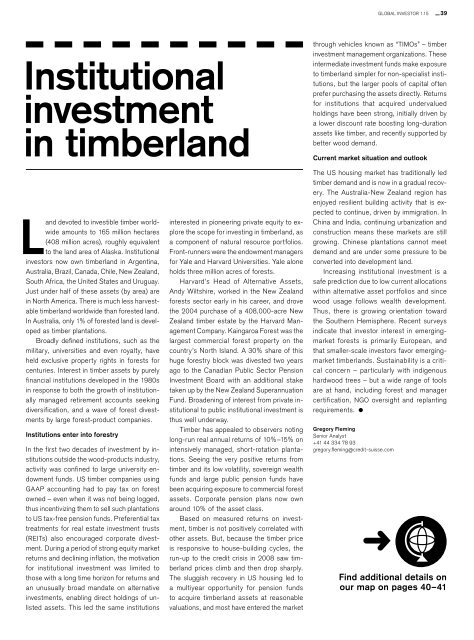Illiquid assets
Unwrapping alternative returns Global Investor, 01/2015 Credit Suisse
Unwrapping alternative returns
Global Investor, 01/2015
Credit Suisse
Create successful ePaper yourself
Turn your PDF publications into a flip-book with our unique Google optimized e-Paper software.
GLOBAL INVESTOR 1.15 — 39<br />
Institutional<br />
investment<br />
in timberland<br />
through vehicles known as “TIMOs” – timber<br />
investment management organizations. These<br />
intermediate investment funds make exposure<br />
to timberland simpler for non-specialist institutions,<br />
but the larger pools of capital often<br />
prefer purchasing the <strong>assets</strong> directly. Returns<br />
for institutions that acquired undervalued<br />
holdings have been strong, initially driven by<br />
a lower discount rate boosting long-duration<br />
<strong>assets</strong> like timber, and recently supported by<br />
better wood demand.<br />
Current market situation and outlook<br />
Land devoted to investible timber worldwide<br />
amounts to 165 million hectares<br />
(408 million acres), roughly equivalent<br />
to the land area of Alaska. Institution al<br />
investors now own timberland in Argentina,<br />
Australia, Brazil, Canada, Chile, New Zealand,<br />
South Africa, the United States and Uruguay.<br />
Just under half of these <strong>assets</strong> (by area) are<br />
in North America. There is much less harvestable<br />
timberland worldwide than forested land.<br />
In Australia, only 1% of forested land is developed<br />
as timber plantations.<br />
Broadly defined institutions, such as the<br />
military, universities and even royalty, have<br />
held exclusive property rights in forests for<br />
centuries. Interest in timber <strong>assets</strong> by purely<br />
financial institutions developed in the 1980s<br />
in response to both the growth of institutionally<br />
managed retirement accounts seeking<br />
diversification, and a wave of forest divestments<br />
by large forest-product companies.<br />
Institutions enter into forestry<br />
In the first two decades of investment by institutions<br />
outside the wood-products industry,<br />
activity was confined to large university endowment<br />
funds. US timber companies using<br />
GAAP accounting had to pay tax on forest<br />
owned – even when it was not being logged,<br />
thus incentivizing them to sell such plantations<br />
to US tax-free pension funds. Preferential tax<br />
treatments for real estate investment trusts<br />
(REITs) also encouraged corporate divestment.<br />
During a period of strong equity market<br />
returns and declining inflation, the motivation<br />
for institutional investment was limited to<br />
those with a long time horizon for returns and<br />
an unusually broad mandate on alternative<br />
investments, enabling direct holdings of unlisted<br />
<strong>assets</strong>. This led the same institutions<br />
interested in pioneering private equity to explore<br />
the scope for investing in timberland, as<br />
a component of natural resource portfolios.<br />
Front-runners were the endowment managers<br />
for Yale and Harvard Universities. Yale alone<br />
holds three million acres of forests.<br />
Harvard’s Head of Alternative Assets,<br />
Andy Wiltshire, worked in the New Zealand<br />
forests sector early in his career, and drove<br />
the 2004 purchase of a 408,000-acre New<br />
Zealand timber estate by the Harvard Management<br />
Company. Kaingaroa Forest was the<br />
largest commercial forest property on the<br />
country’s North Island. A 30% share of this<br />
huge forestry block was divested two years<br />
ago to the Canadian Public Sector Pension<br />
Investment Board with an additional stake<br />
taken up by the New Zealand Superannuation<br />
Fund. Broadening of interest from private institutional<br />
to public institutional investment is<br />
thus well underway.<br />
Timber has appealed to observers noting<br />
long-run real annual returns of 10%–15% on<br />
intensively managed, short-rotation plantations.<br />
Seeing the very positive returns from<br />
timber and its low volatility, sovereign wealth<br />
funds and large public pension funds have<br />
been acquiring exposure to commercial forest<br />
<strong>assets</strong>. Corporate pension plans now own<br />
around 10% of the asset class.<br />
Based on measured returns on investment,<br />
timber is not positively correlated with<br />
other <strong>assets</strong>. But, because the timber price<br />
is responsive to house-building cycles, the<br />
run-up to the credit crisis in 2008 saw timberland<br />
prices climb and then drop sharply.<br />
The sluggish recovery in US housing led to<br />
a multiyear opportunity for pension funds<br />
to acquire timberland <strong>assets</strong> at reasonable<br />
valuations, and most have entered the market<br />
The US housing market has traditionally led<br />
timber demand and is now in a gradual recovery.<br />
The Australia-New Zealand region has<br />
enjoyed resilient building activity that is expected<br />
to continue, driven by immigration. In<br />
China and India, continuing urbanization and<br />
construction means these markets are still<br />
growing. Chinese plantations cannot meet<br />
demand and are under some pressure to be<br />
converted into development land.<br />
Increasing institutional investment is a<br />
safe prediction due to low current allocations<br />
within alternative asset portfolios and since<br />
wood usage follows wealth development.<br />
Thus, there is growing orientation toward<br />
the Southern Hemisphere. Recent surveys<br />
indicate that investor interest in emergingmarket<br />
forests is primarily European, and<br />
that smaller-scale investors favor emergingmarket<br />
timberlands. Sustainability is a critical<br />
concern – particularly with indigenous<br />
hardwood trees – but a wide range of tools<br />
are at hand, including forest and manager<br />
certification, NGO oversight and replanting<br />
requirements.<br />
Gregory Fleming<br />
Senior Analyst<br />
+41 44 334 78 93<br />
gregory.fleming@credit-suisse.com<br />
Find additional details on<br />
our map on pages 40–41

















